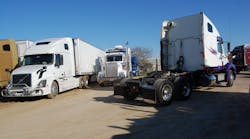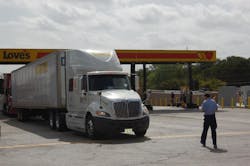In order to gain more supply chain efficiencies and cost savings in an increasingly tight truck capacity environment driven by a growing shortage of drivers, more “collaborative” relationships are expected to be formed between shippers, third party logistics (3PL) providers, freight brokers and motor carriers over the next five years – even among erstwhile competitors, according to several industry observers.
“It’s definitely one of the best ways to achieve greater modal or supply chain efficiency, especially in light of the many additional pressures today’s shippers are under,” Scott Trainor, senior manager-global marketing at APL Logistics, explained to Fleet Owner.
Years ago, he said, logistics was a matter of delivering the right product to the right place at the right time and in the right condition.“Today, though, you also have to add ‘via the right sales channel’ and ‘at the lowest possible price,’ to that description,” Trainor emphasized.
“Today’s customers expect considerably faster, more agile and more multi-faceted service … even smaller, more frequent deliveries. In addition, many consumers are beginning to consider same-day delivery something that every company should be able to do,” he noted.
[APL Logistics delved into such “collaborative” topics more deeply in a white paper that can be accessed here.]
“Yet there are huge constraints within the shipping industry, including volatile fuel prices, high transportation congestion in certain markets and the ever-present elephant in the room: the ongoing driver shortage,” Trainor pointed out.
From that perspective, APL Logistics believes collaboration offers numerous advantages in light of those challenges and expectations:
- Identifying and taking advantage of shared transportation opportunities;
- Providing better customer service, such as more frequent deliveries, to companies that are demanding it;
- And achieving better economies of scale and more sustainable results through the use of shared resources.
Kim Drouillard, director of sales and Implementation for Omnitracs Sylectus, told Fleet Owner that such “sharing” of transportation can even occur among motor carriers themselves to help balance out their networks.
“When a carrier has a lack of capacity or lack of freight to fill their trucks, they can reach out to partner carriers … via a ‘controlled’ network used to share one another’s loads and equipment,” she explained; carriers connected by neutral Internet-based platforms such as the one provided by Omnitracs Sylectus.
“That way carriers can have faith that their freight will be taken care of as if it was their own drivers handling it,” Drouillard noted.
“The efficiency gain of this integration is a significant reduction in the amount of calls coming into dispatch which will free up dispatchers time to work on moving more freight,” she added. “Carriers also reduce empty miles and fill trucks to capacity utilizing the alliance network; thus the cost savings and revenue gains can be substantial.”
Drouillard expects to see more collaboration amongst shippers, brokers and carriers – and also truck drivers as well – over the next five years in part because consumers have higher expectations for products to be delivered "ASAP."
“Online ordering especially allows you to choose when you want your purchase to be delivered,” she pointed out.
APL Logistics’ Trainor noted that such “technology-enabled transparency” is the “lifeblood” of collaborative relationships, because in order to find the best opportunities, key players in a relationship must have 20-20 visibility of various factors like orders, available inventory and shipment status.
“One of the common complaints some of today’s shippers have is that even though they’ve tried to give their carriers better forecasting data and other information – letting them know what’s coming down their pipeline several weeks in advance for example – most carriers still don’t seem to value it or use it effectively,” he said. “That’s a shame, because it can make a huge difference in terms of how well shippers and their carriers can work together to improve shipping efficiency” especially in terms of allowing carriers to design more efficient pick-up schedules.
And designing more efficient routes, pickup, and delivery schedules will be critical as Trainor said the truck driver shortage remains a “huge issue” that is forcing the accelerated adoption of numerous best practices throughout the freight industry.
“Logistics professionals understand that focusing on replacing capacity alone isn’t going to be enough to solve the issue at hand – and that all of us with skin in the game are going to have to do our fair share to address driver shortage and truck capacity constraints in other ways,” he stressed.
“Successful collaborative shippers will not only help themselves make smarter use of an increasingly finite resource through better routing and optimization, they’ll also succeed in helping trucking companies enhance their ability to serve more shippers with less effort,” he emphasized. “It’s a win-win for everyone.”




